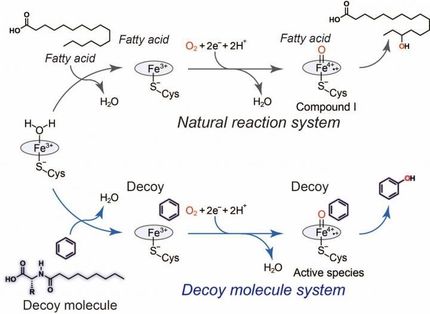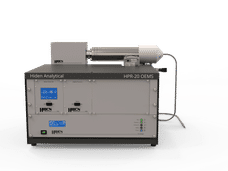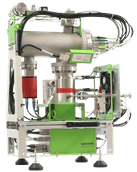Teamwork against Benzene
Advertisement
The carcinogenic harmful substance benzene can seriously impact the soil and ground water following chemical accidents or at old industrial sites. Nevertheless, bacteria exist which can degrade this compound even in the absence of oxygen. Until now it was not clear which organisms take part in this process and how they work together. With modern analytical procedures scientists of the Helmholtz Centre for Environmental Research (UFZ) have succeeded for the first time in tracking the path of this harmful substance through such a bacterial community with proteins. Accordingly, three teams of microbial harmful substance eliminators cooperate, each with its own tasks. In the professional publication ISME Journal, the researchers say that this method could also help to clarify the complex processes in other bacterial cooperatives.
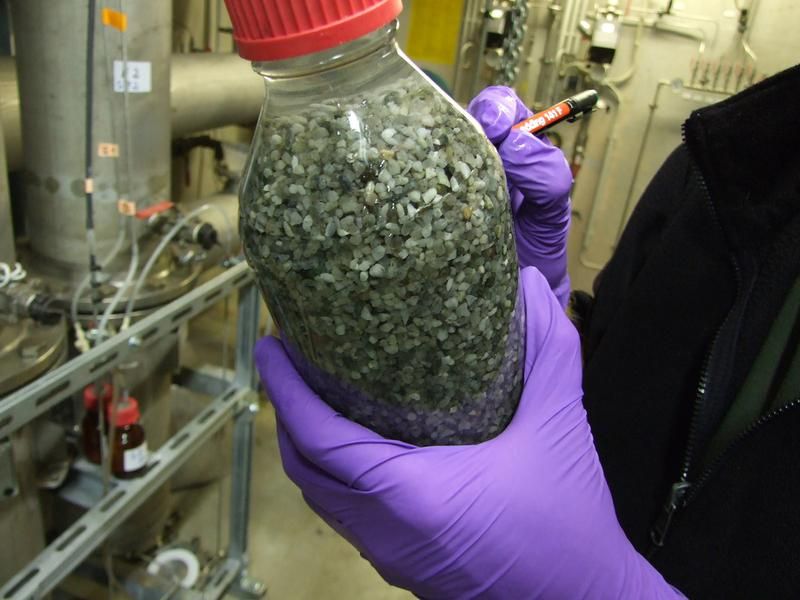
Analysis of samples from Zeitz
Martin Taubert/UFZ
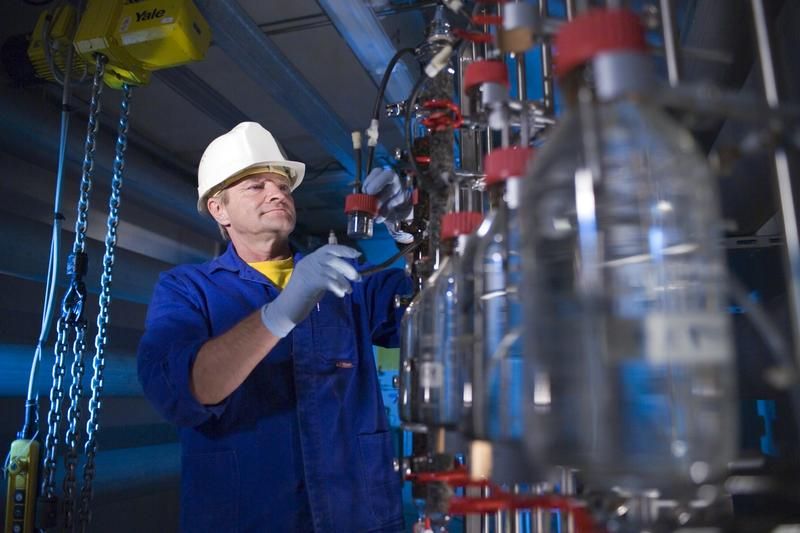
SAFIRA Test site in Zeitz
André Künzelmann/UFZ
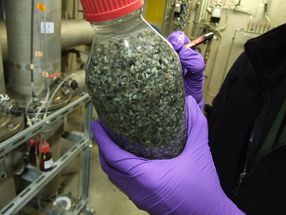
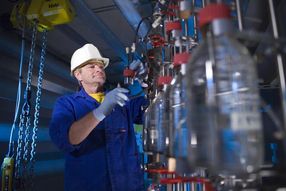
On the premises of the former Zeitz hydrogenation plant in Saxony-Anhalt traces of chemicals from earlier times are still present. The plant began the extraction of liquid fuels and lubricants from lignite in 1938. When the allied forces bombed and largely destroyed the plant in the final months of the Second World War, large amounts of harmful substances seeped into the ground and into the ground water. Further impacting came during the era of East Germany when Zeitz developed to a centre for the processing of coal and crude oil. In the meantime the old production facilities have been torn down and the required restoration work is continuing under the direction of the federal state of Saxony-Anhalt. However, residual contamination, particularly in the deeper areas, will remain. In the sediment and ground water, above all a group of compounds is found which chemists refer to by the abbreviation BTEX. This stands for the highly volatile aromatic compounds benzene, toluene, ethyl benzene and xylene. Particularly benzene can be detected in relevant concentrations.
Benzene a "hot" harmful substance
Benzene is of special significance for the environment, because this compound is carcinogenic and damaging to the central nervous system. Higher concentrations can lead to unconsciousness and respiratory paralysis and can be damaging to health even in low concentrations.
A variety of products from plastics and resins to pesticides and paints derives from benzene. Furthermore, it is also an important component of petrol. Thus, there are many sources of pollution. Benzene can penetrate into the environment as a result of chemical accidents and is also found in the areas surrounding oil refineries and tank storage facilities, petrol stations and well-travelled roads. Consequently, for many years researchers from the UFZ have been investigating the possibilities for the remediation of such impacted areas. This is also of interest for other areas. "In Germany, to be sure, for many years the problems caused by this harmful substance have been declining", says Martin von Bergen, Head of the Proteomics Department at the UFZ. Nevertheless, this in no way applies for other countries, as this expert is aware: "In China, for example, pollution is increasing dramatically". Thus, in November 2005 around 100 tonnes of benzene flowed into the Songhua River, following an accident in a chemical plant. This resulted in a toxic plume 80 kilometres long and reached the city of Harbin, with a population of several million, making the interruption of the supply of drinking water to the city necessary.
Nevertheless, bacteria exist which can degrade such pollution again. Provided that there is a sufficient supply of oxygen, this takes place relatively quickly. However, when the substance seeps into the ground it soon reaches regions with only little oxygen or none at all. "And no one knows exactly what happens there", says Martin von Bergen. It is in fact clear that degradation still takes place, even in the absence of oxygen, as earlier studies at the UFZ in which, above all, scientists of the Department of Isotope Biogeochemistry collaborated, have shown. Biochemists can explain part of this process relatively well. However, the first step of the biological attack against benzene remains a mystery so far. Indeed, until recently researchers had only limited conceptions of the bacteria taking part and their respective tasks.
Search for evidence in the microbial sphere
This has now changed. For the first time the new study, in which scientists of the Departments of Soil Ecology, Environmental Microbiology, Isotope Biogeochemistry and Proteomics collaborated, showed a rather detailed picture of the benzene eliminator community. "This was not a question of identifying every single type taking part", explains Martin von Bergen. This is generally difficult with environmental samples, because many of the types taking part have not yet even been described. Moreover, in the microbial realm "type" is a rather vague concept posing difficulties even for experts.
On the other hand, we can readily differentiate between groups having different functions. "Bacteria are team players", explains Martin von Bergen. Just as there are specialists for management, bookkeeping or production within a company, the degradation of benzene requires the cooperation of microorganisms with different talents. Whether or not one or several types serve to perform a given task is of secondary importance. Important is that the job gets done.
In order to investigate the nature of this division of tasks amongst the microbial benzene fans the researchers took samples of impacted underground water from Zeitz for analysis in the laboratory. There they subjected the proteins of the organisms to a so-called isotopic analysis. This procedure is based on the existence of two different highly stable carbon variants in nature. The lighter and far more frequently occurring of these isotopes is known as 12C and the heavier as 13C. The researchers offered the bacteria benzene molecules in which the heavier version was significantly enriched. They then investigated the extent to which the organisms incorporated this isotope in their proteins. This was determined by analysing fragments of the proteins with a mass spectrometer.
The harmful substance eliminator team
"This investigation provides us with two interesting types of information", explains Martin von Bergen. On the one hand, by comparing with databases we can determine the bacterial groups to which the protein fragments belong. In order to verify these results, the researchers also utilised modern methods to cast a glance into the genetic material of the microbe crew. "In this way, we were able to gain a genetic overview of the members of the bacterial community", says the UFZ researcher.
However, the second result of the isotopic analyses was still more interesting, as these analyses reveal information about the metabolism of the individual organisms. Decisive here is the amount of 13C found in the proteins as a function of time. "Here there are typical patterns, according to the source of nutrition", explains Martin von Bergen. Thus, the researchers succeeded in identifying a group of bacteria in which the 13C content immediately rises and then hardly increases any more. These microbes feed directly on 13C benzene. In a second group, on the other hand, larger concentrations of the isotope in the proteins are found only over a longer period of time. These organisms do not feed directly on the harmful substance itself, but live from its degradation products. Finally, there is also a third group, in which the 13C concentration remains at a low level over the entire time. These are presumably scavengers, which live from the remains of other bacteria.
"We have therefore succeeded in tracking the path of benzene atoms through the entire bacterial community", says Martin von Bergen proudly. The researchers have not only discovered who ingests what in which amounts. They now know more about how the co-operation between the different teams of bacteria functions. Thus, the directly feeding bacteria for the degradation of benzene presumably produce both acetate and hydrogen. However, they must release both substances, as these would otherwise inhibit their metabolism. Here the organisms of the second group, which feed only indirectly on the harmful substance, come to their aid by utilising the acetate as a source of carbon and eliminating the hydrogen.
A new look at sewage sludge and the intestinal tract
"Such co-operations of course not only exist amongst benzene eliminators", says Martin von Bergen. With the aid of their methods he and his colleagues hope to be able to analyse other complex bacterial communities. For example, it would be possible to investigate the co-operation of different microbes in biogas plants or in sewage sludge. An understanding of these processes would make better control of the processes possible in such plants. Such investigations can also furnish new knowledge for medicine. One knows, for example, that thin persons have other
microorganisms in the gastrointestinal tract than obese persons. In addition, the bacterial flora also appear to influence the immune system. One would like to know more about all of these relationships in order to help people lose weight or reinforce their natural defences, for example.
"Bacterial communities live everywhere, from the flower pot to within the human body", Martin von Bergen sums up. Previously microbiologists investigated above all which organisms occur where. However, now they want to know more about their activities and co-operations. For Martin von Bergen and his colleagues this "functional biodiversity" is a promising subject for future research. These exciting approaches could also play a role within the scope of the new Biodiversity Research Centre of the German Research Foundation (DFG), with the joint participation of the Universities of Leipzig, Halle and Jena and the UFZ.
Original publication
Other news from the department science
These products might interest you
Most read news
More news from our other portals
See the theme worlds for related content
Topic World Mass Spectrometry
Mass spectrometry enables us to detect and identify molecules and reveal their structure. Whether in chemistry, biochemistry or forensics - mass spectrometry opens up unexpected insights into the composition of our world. Immerse yourself in the fascinating world of mass spectrometry!

Topic World Mass Spectrometry
Mass spectrometry enables us to detect and identify molecules and reveal their structure. Whether in chemistry, biochemistry or forensics - mass spectrometry opens up unexpected insights into the composition of our world. Immerse yourself in the fascinating world of mass spectrometry!




